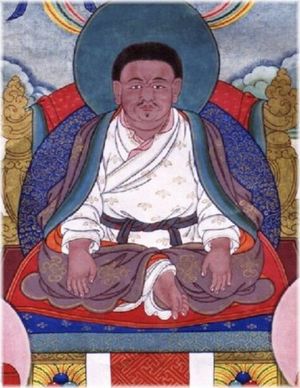Mahamudra: Difference between revisions
Jump to navigation
Jump to search
No edit summary |
|||
| Line 1: | Line 1: | ||
'''Mahamudra''' (Skt. ''Mahāmudrā''; Tib. ''Chakgya Chenpo''; [[Wyl.]] ''phyag rgya chen po''), or ‘Great Seal’ | [[Image:Marpa.jpg|thumb|[[Marpa Lotsawa]] courtesy of Shechen Archives]] | ||
'''Mahamudra''' (Skt. ''Mahāmudrā''; Tib. ''Chakgya Chenpo''; [[Wyl.]] ''phyag rgya chen po''), or ‘Great Seal’ is the [[meditation]] tradition of the [[Kagyü]] lineage which passed from [[Maitripa]] and [[Naropa]] in India to [[Marpa Lotsawa]] in Tibet. | |||
==Definition== | |||
''Mudra'' means that it encompasses all phenomena of [[samsara]], [[nirvana]], and the path. In other words, they are 'sealed' within it. It is called ''maha'' or “great,” because nothing is superior to it. | |||
==Subdivisions or Levels of Interpretation== | ==Subdivisions or Levels of Interpretation== | ||
| Line 5: | Line 9: | ||
* '''Tantric Mahamudra''' is related to the inner yogas and the practice of [[dzogrim]]. | * '''Tantric Mahamudra''' is related to the inner yogas and the practice of [[dzogrim]]. | ||
* '''Essence Mahamudra''' ([[Wyl.]] ''ngo bo'i phyag rgya chenpo'') is closer to [[Dzogchen]] and is described in terms of a meditative practice leading to the [[nature of mind]]. | * '''Essence Mahamudra''' ([[Wyl.]] ''ngo bo'i phyag rgya chenpo'') is closer to [[Dzogchen]] and is described in terms of a meditative practice leading to the [[nature of mind]]. | ||
==Relationship to Dzogchen== | |||
[[Jamgön Kongtrul]] said that Mahamudra corresponds to the [[Mind category|Semdé]] teachings of [[Dzogchen|Dzogpachenpo]].<ref>*Ringu Tulku, ''The Ri-me Philosophy of Jamgön Kongtrul the Great'', Shambhala Publications, 2006</ref> | |||
==Notes== | |||
<small><references/></small> | |||
==Further Reading== | ==Further Reading== | ||
| Line 13: | Line 23: | ||
==Internal Links== | ==Internal Links== | ||
*[[ | *[[Four yogas]] | ||
[[Category:Key Terms]] | [[Category:Key Terms]] | ||
[[Category:Mahamudra]] | [[Category:Mahamudra]] | ||
Revision as of 05:19, 22 March 2010

Mahamudra (Skt. Mahāmudrā; Tib. Chakgya Chenpo; Wyl. phyag rgya chen po), or ‘Great Seal’ is the meditation tradition of the Kagyü lineage which passed from Maitripa and Naropa in India to Marpa Lotsawa in Tibet.
Definition
Mudra means that it encompasses all phenomena of samsara, nirvana, and the path. In other words, they are 'sealed' within it. It is called maha or “great,” because nothing is superior to it.
Subdivisions or Levels of Interpretation
- Mahamudra of the sutra system refers to the attainment of perfect enlightenment through the five paths and ten bhumis.
- Tantric Mahamudra is related to the inner yogas and the practice of dzogrim.
- Essence Mahamudra (Wyl. ngo bo'i phyag rgya chenpo) is closer to Dzogchen and is described in terms of a meditative practice leading to the nature of mind.
Relationship to Dzogchen
Jamgön Kongtrul said that Mahamudra corresponds to the Semdé teachings of Dzogpachenpo.[1]
Notes
- ↑ *Ringu Tulku, The Ri-me Philosophy of Jamgön Kongtrul the Great, Shambhala Publications, 2006
Further Reading
- Dakpo Tashi Namgyal, Mahamudra, The Moonlight: Quintessence of Mind and Meditation, translated by Lobsang P. Lhalungpa, Wisdom Publications, 2nd ed. 2006.
- Kalu Rinpoche, The Union of Mahamudra and Dzogchen, Khyentse Özer, Rigpa, London, 1990.
- Khenchen Thrangu Rinpoche, Crystal Clear: Practical Advice for Mahamudra Meditators, translated by Erik Pema Kunsang, Ragjung Yeshe, 2004.
- Tsele Natsok Rangdrol, Lamp of Mahamudra, Shambhala, 1989.